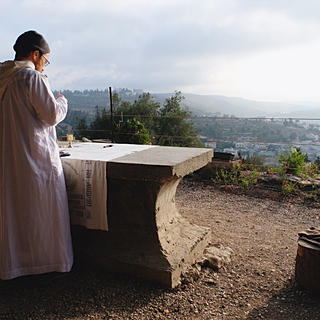Hike to a Monastery on a Cliff
- Beatitudes Missions
- May 29, 2018
- 3 min read
On Sunday we drove down from Jerusalem into the Judean Desert. As we dropped below sea level, the landscape around us gradually transformed from scrub-covered hills into crumbling rock, the truest desert any of us had experienced.

We stopped for breakfast at Jericho Lookout. Behind us, and a thousand feet above, the outskirts of Jerusalem were barely visible over the Mount of Olives. The valleys sprawled out before us, giving us a peek over the distant hills at the lowest and perhaps oldest city on Earth. Beyond Jericho and the Jordan Valley lay Nebo (where Moses passed away) and the mountains of Moab in Jordan.
Side-stepping the Bedouin peddlers, we got back in the car and headed down again on a one-lane paved road. Fr. Anthony pulled over at what seemed like the middle of nowhere and had us gear up with sunscreen, sunglasses, and hats. We began walking up the first hill with only a vague idea of where we were going and, by the end, we could not believe where we had gone.

At the crest of the hill, we could see our destination in the gorge below. It was a shock to see a beautiful oasis in the middle of the nothingness: the fourth-century Monastery of St. George. There, a group of Eastern Orthodox monks keeps the traditions of secluded monastic life and provides a place for pilgrims to pause and pray on their way. The third-century Roman soldier and martyr St. George remains to this day the patron saint of Christians in the Holy Land, and his tomb is venerated in the Orthodox church of Lod (Lydda in Acts 9). His image on horseback killing a dragon is often chiseled into the lintel of Palestinian front doors.
The trail leading down to the monastery was full of pilgrims on foot and on the backs of donkeys. After trekking down the steep trail into the Wadi Kelt gorge for half an hour in the dry desert heat, we arrived at the holy oasis. What a beautiful feat of architecture, appearing to be carved out of the cliffs themselves.
With a Greek grin, a monk greeted us at the entrance and beckoned us in. We passed through a terrace filled with exotic desert plants and into the main open-air room. Cool water and watermelon juice awaited our arrival. The monks also offered us a pot of sweet Turkish coffee and a dish of candies.
Rhythmic chanting resonated from the chapel, and there we discovered a group of Romanians venerating the incorrupt body of the former abbot through the glass top of his tomb. His half-withered hand stuck out from under his vestments. We mingled into the line of kerchiefed women crossing themselves, kissing the icons, and taking photos of the coffin. Upstairs, a cave formed another chapel, housing a striking icon of Elijah. We happened to ask the monk about it, and he noted that the ravens fed the prophet on this very spot. In the gloomy back of the cave lay an altar with Mass vessels and a censor ready for liturgy.

Outside the monastery walls, cave after cave dotted the cliff sides where monks would go to live in solitude, some of them walled up with large stone blocks and some of them with ropes and sketchy wooden stairs outside to give access. We continued down the trail on the wall of the wadi on our way to Jericho…until next time, friends!















Comments